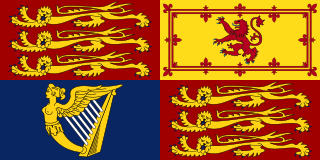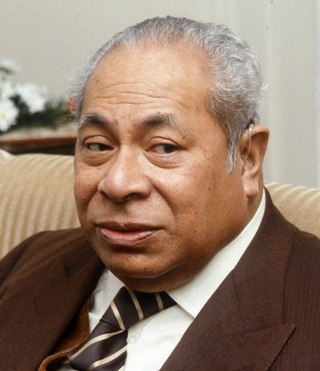A monarch is a head of state for life or until abdication, and therefore the head of state of a monarchy. A monarch may exercise the highest authority and power in the state, or others may wield that power on behalf of the monarch. Usually a monarch either personally inherits the lawful right to exercise the state's sovereign rights or is selected by an established process from a family or cohort eligible to provide the nation's monarch. Alternatively, an individual may proclaim oneself monarch, which may be backed and legitimated through acclamation, right of conquest or a combination of means.
A monarchy is a form of government in which a person, the monarch, is head of state for life or until abdication. The political legitimacy and authority of the monarch may vary from restricted and largely symbolic, to fully autocratic, and can span across executive, legislative, and judicial domains.

The monarchy of the United Kingdom, commonly referred to as the British monarchy, is the form of government used by the United Kingdom by which a hereditary monarch reigns as the head of state, with their powers regulated by the British Constitution. The term may also refer to the role of the royal family within the UK's broader political structure. The current monarch is King Charles III, who ascended the throne on 8 September 2022, upon the death of his mother, Queen Elizabeth II.
A prince consort is the husband of a monarch who is not a monarch in his own right. In recognition of his status, a prince consort may be given a formal title, such as prince. Most monarchies do not allow the husband of a queen regnant to be titled as a king because it is perceived as a higher title than queen, however, some monarchies use the title of king consort for the role.

A dynasty is a sequence of rulers from the same family, usually in the context of a monarchical system, but sometimes also appearing in republics. A dynasty may also be referred to as a "house", "family" or "clan", among others.
A golden jubilee marks a 50th anniversary. It variously is applied to people, events, and nations.

The royal standards of the United Kingdom presently refer to either of two similar flags used by King Charles III in his capacity as sovereign of the United Kingdom, the Crown dependencies, and the British Overseas Territories. Two versions of the flag exist, one for use within Scotland and the other for use elsewhere.

Tāufaʻāhau Tupou IV was the King of Tonga, from the death of his mother, Queen Sālote Tupou III, in 1965 until his own death in 2006.

The monarchy of New Zealand is the constitutional system of government in which a hereditary monarch is the sovereign and head of state of New Zealand. The current monarch, King Charles III, acceded to the throne following the death of his mother, Queen Elizabeth II, on 8 September 2022 in the United Kingdom. The King's elder son, William, Prince of Wales, is the heir apparent.

A queen regnant is a female monarch, equivalent in rank, title and position to a king. She reigns suo jure over a realm known as a kingdom; as opposed to a queen consort, who is married to a reigning king; or a queen regent, who is the guardian of a child monarch and rules pro tempore in the child's stead or instead of her husband who is absent from the realm, be it de jure in sharing power or de facto in ruling alone. A queen regnant is sometimes called a woman king. A princess regnant is a female monarch who reigns suo jure over a principality; an empress regnant is a female monarch who reigns suo jure over an empire.
Majesty is used as a manner of address by many monarchs, usually kings or queens. Where used, the style outranks the style of (Imperial/Royal) Highness, but is inferior to the style of Imperial Majesty. It has cognates in many other languages, especially of Europe.

The monarchy of Australia is a key component of Australia's form of government, embodied by the Australian sovereign and head of state. The Australian monarchy is a constitutional one, modelled on the Westminster system of parliamentary government, while incorporating features unique to the constitution of Australia.

The monarchy of Jamaica is a system of government in which a hereditary monarch is the sovereign and head of state of Jamaica. The current Jamaican monarch and head of state, since 8 September 2022, is King Charles III. As sovereign, he is the personal embodiment of the Jamaican Crown. Although the person of the sovereign is equally shared with 14 other independent countries within the Commonwealth of Nations, each country's monarchy is separate and legally distinct. As a result, the current monarch is officially titled King of Jamaica and, in this capacity, he and other members of the royal family undertake public and private functions domestically and abroad as representatives of the Jamaican state. However, the monarch is the only member of the royal family with any constitutional role.
Heads of state throughout the world and at all periods of history may be ranked according to characteristics such as length of time holding that position; age of accession or death; or physical attributes. World records in these characteristics may be identified, though the historical basis for such claims is frequently uncertain.

Elizabeth II was Queen of the United Kingdom and other Commonwealth realms from 6 February 1952 until her death in 2022. She was queen regnant of 32 sovereign states over the course of her lifetime and remained the monarch of 15 realms by the time of her death. Her reign of 70 years and 214 days is the longest of any British monarch or female monarch, and the second longest verified reign of any monarch of a sovereign state in history.
A queen mother is a former queen, often a queen dowager, who is the mother of the reigning monarch. The term has been used in English since the early 1560s. It arises in hereditary monarchies in Europe and is also used to describe a number of similar yet distinct monarchical concepts in non-European cultures around the world. The rank does not go to all mothers of monarchs though. A mother of a ruling monarch may only be referred to as Queen Mother if she was a Queen Consort as opposed to a Princess Consort.

Hassanal Bolkiah ibni Omar Ali Saifuddien III is Sultan of Brunei since 1967 and the prime minister of Brunei since independence from the United Kingdom in 1984.









